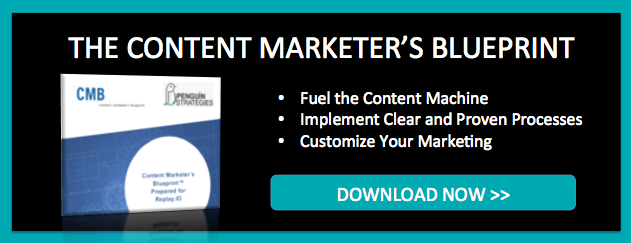
Most advice about business blogging emphasizes the importance of capturing and retaining your audience’s attention. And that’s true: In the digital world, there’s no such thing as polite tolerance for rambling, boring stories.
But that doesn’t necessarily mean that a popular blog post is a successful one. Social metrics are a nice feel-good, and the mantra of “the more eyeballs, the better” is true -- to a point.
But unless the sole purpose of your blog is to generate ad revenue, social metrics do little to further business strategy. Even viral posts don’t necessarily impact the bottom line.
To do that, you have to clarify the purpose behind each piece of content you publish. That means thinking through the answers to the following three questions.
1. WHO IS YOUR AUDIENCE?
This question goes beyond demographics and customer personae (although those things are important, too). Your ultimate goal is to convert readers into customers, so make sure to write for people who are likely to buy what you sell -- or to recommend you to others who may buy.
Mistake #1: Writing for people who do what you do
There are two main ways you can end up writing for the wrong audience. The first is by writing for people who do what you do instead of people who may buy what you do. Here’s an example: A mechanic writes detailed, authoritative, highly actionable blog posts about how to fix cars. The blog will probably be wildly popular among other mechanics, but it’s unlikely to attract new customers. It could garner great social metrics without a single conversion. In a nutshell, the mechanic would be aiding and abetting his competition, not marketing his business.
Mistake #2: Writing for your customers’ customers
Another common mistake is writing for your customers’ customers. A farmer who writes about creative ways to cook with fresh produce, for example, may very well inspire people to try those recipes. But that will only help the farmer if grocery stores sell the farmer’s products. Our hypothetical farmer would be better off blogging for grocery stores about the best ways to keep produce fresh, how to convince customers to try something new, etc.
The bottom line is that business blogs should drive business -- and that means they need to target people who make buying decisions for whatever it is that you sell.
2. What do you want them to think, do, or feel after reading your content?

This is broader than a call to action, especially if you’re targeting top-of-the-funnel prospects. A call to action might be something like, “Click here to follow our blog.” But the overarching goal of content marketing is to turn readers into customers. So possible answers to this question could include things like:
To recognize the need for a product or service
When trying to engage new prospects, your goal is to simply help readers recognize a need or want they were previously unaware of. A data security company, for example, might want to make people who sell things online aware of their responsibility to protect customers’ payment information. In that scenario, the purpose of a piece of content could be to provoke an, “Uh oh, I’d better think about this,” reaction.
To see you as a trusted resource
This is about building trust and respect -- getting people to think, “This business knows what they’re doing and wants to help.” Even if customers aren’t in a buying mode when they read your content, it lays the groundwork for being on their short list when they are ready to buy.
To understand how to get the most out of your product or service
Customers who are happy with their first purchase are likely to make another. Blog posts that cause customers to think, “Wow, look what I can do with this!” pave the way for future purchases.
RELATED: OPTIMIZING BLOGS: YOUR ESSENTIAL SEO CHECKLIST
3. Why is that important?
This question is just for you and covers your behind-the-scenes goals -- the ones you might not state explicitly -- and the answer should shape the way you frame the content. Why do you want customers to think, do, or feel a certain way after reading your content? How will that help you accomplish your business goals?
To reduce returns
A common cause for returns is customer misuse. Some products, for example, shouldn’t be left in a hot car. If you’re getting swamped with damaged returns from products that were left in cars, you might write a blog post on why it’s important to not let your product become overheated. The answer to “What do you want customers to think, feel, or do?” would be “Stop leaving the product in cars.” But the answer to “Why is that important?” would be “To reduce returns.”
To prepare customers for a price increase
When the cost of doing business goes up, prices go up accordingly. But customers who don’t understand that may get angry about price increases, blaming your company for being greedy. If you were to write a blog post about new regulations in your industry, the answer to “What do you want customers to think, do, or feel?” might be something like, “Realize that reducing carbon emissions has an associated cost.” The answer to “Why is that important?”, on the other hand, would be “So they won’t be surprised and angry when prices go up in a few months.”
To persuade customers to choose your product over a competitor’s
Businesses often blog about why their products are superior to those of their competitors, whether it’s because of materials used, manufacturing processes, or some other factor. Unfortunately, those blogs often focus on the details of the differences instead of explaining why they matter. Customers won’t care that you use different materials or processes, for instance, unless they also understand that those differences make your product last longer.
In today’s business world, it’s safe to say that, if you don’t have online content, you don’t exist. So you could make an argument in favour of having content just to have content. But why settle for content that just takes up space when you could be publishing content that matters? Each piece of content is an opportunity to further your business goals. Don’t waste it.

by The Penguin Team on July 03, 2017
As a leading B2B digital marketing agency, We help B2B Technology Companies, enterprise software, and hardware companies increase brand awareness, reach more qualified leads and close more customers. Penguin Strategies is a Diamond Partner of HubSpot.






